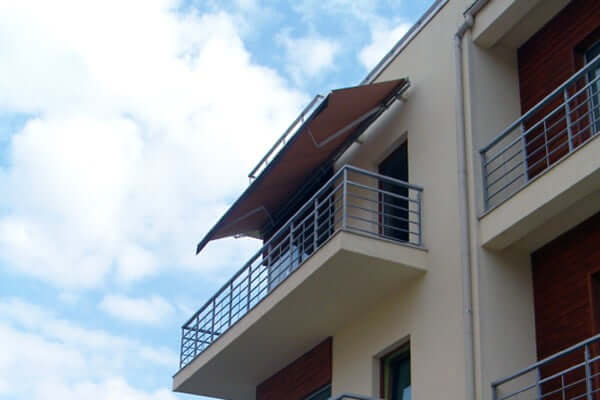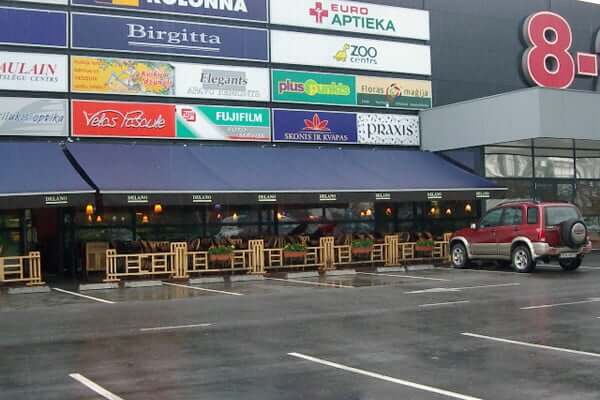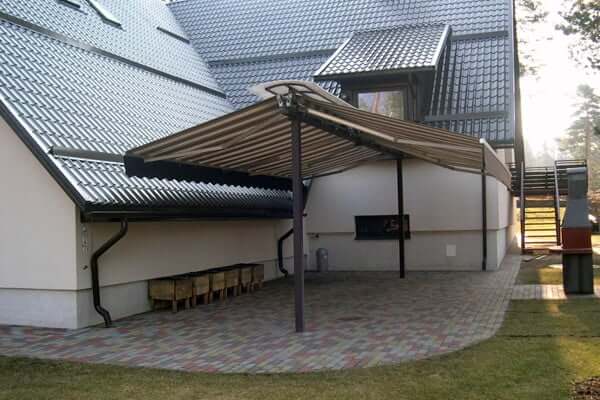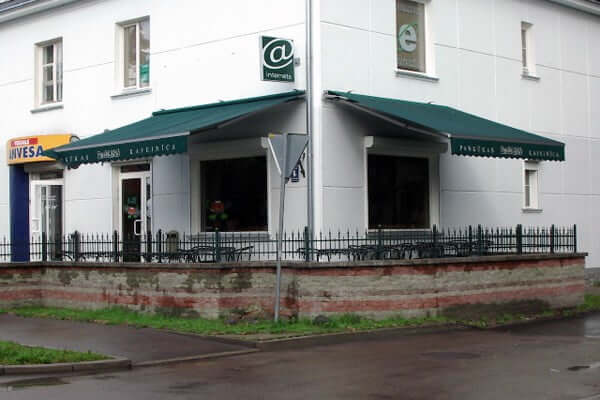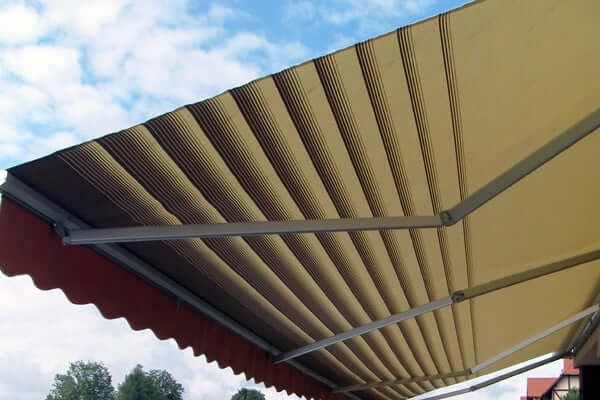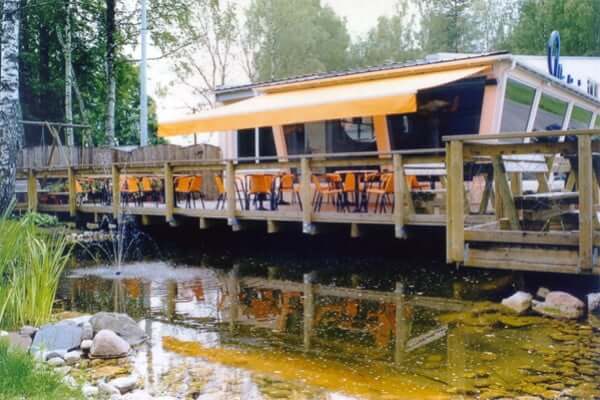Exceptional models have purpose-designed aluminium coverboard profile to this system, which protects the fabric and mechanism from the elements when the awning is retracted, this forms a good seal to the wall, and makes this awning perfect for creating large areas of outdoor covered space for recreation.
Just give us a call. We’ll give you all the advice you need.
Awnings and energy saving
You can reduce room temperature by more than 5 degrees by equipping glazed surfaces in your house with awnings.
Thus awnings represent a good and truly natural solution and allow to enjoy the area they cover, as well as help to save energy significantly.
Since 2002 the European Parliament considers sun-protection awnings to be a solution for reducing energy costs of buildings. Awnings allow to reduce energy consumption and greenhouse effect (according to the Kyoto Protocol): in summer awnings prevent heat build-up caused by sunlight coming through glazed surfaces, significantly reducing energy consumed by air conditioning.
Careful studies carried out in various European cities which are located in different solar and climatic conditions discovered that in half of the cases analyzed (25), the houses which were equipped with awnings had small air-conditioning energy consumption (less than 200 kWh per year). This proves that in certain climatic situations the use the awnings allows to go without air conditioning.

These studies show that the most significant reduction in energy consumption by air conditioning was achieved by using external sun-protection systems (awnings) in the southwest area of Rome latitudes. Quite tangible savings were also achieved using awnings on facades, located in northern areas with long sunny summers. The energy consumed by air-conditioning system can be reduced by about 40 KWh/m2 per year, thus increasing buildings’ energy level to the 2nd or 3rd category.
Even in the areas that are less exposed to sunshine, such as Brussels, Budapest, and Stockholm, the energy needed for air conditioning is reduced by 80%.
Awnings have the greatest impact on “energy saving required for air conditioning” in Europe’s southern and western countries;
Awnings allow to reduce CO2 significantly, equivalent to 80 Mt/year, by “energy saving required for air conditioning”..
Selection of awning
When choosing an appropriate awning it is essential to consider the proper ratio between the area to be covered and the awning’s size.
In order to calculate the dimensions of an awning so that it meets the needs of a users, you need to determine the area to be shaded, considering that the shadow area depends on the location of the covering surface, the angle of sunlight and the time of the day.
For example:
Lunch with friends in August, at 13:30! We are on the terrace, which is entirely situated on the southern side of Italy.
Some friends sit down at the table. Let’s assume there is one garden table (0.80 m) + 2 persons sitting at the table (2 x 0.5 m) + distance from the wall 0.35 m. The minimum area of the shadow to protect everyone from the sun is 2.5 x 4 m = 12 m2.
What size of the awning would ensure adequate shading?



Positioning
Sun rays reach the ground more quickly in the areas located on the southern side rather than on the eastern (in the morning) and western (in the afternoon) sides.
Seasonal fluctuations are largely influenced by the angle of sunlight: in summer the sun is in its highest position, while in winter it is in the lowest position relative to the horizon.

Valances
Based on the location of the surface to be shadowed, the size of the valance should be calculated and adjusted to ensure proper shading.
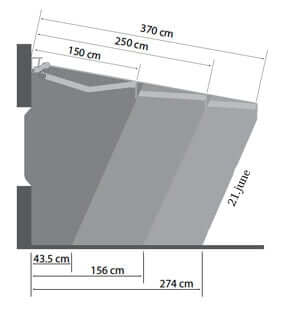
Awning’s inclination angle
Awnings inclination angle plays a fundamental role in shading the selected area. Using the registries it is easy to adjust the angle of inclination. Larger valences of the awnings can provide additional shading, but don’t forget to keep them at appropriate height comfortable for walking under them.
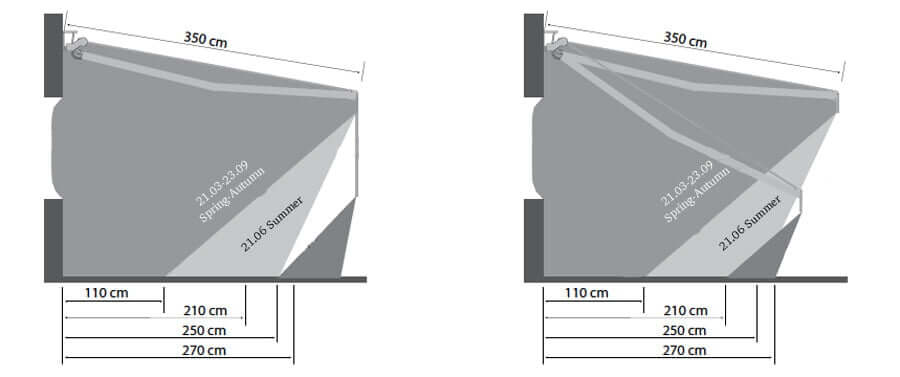
Choosing fabrics and colors
Nowadays sun-protection has become a significant problem, because solar radiation has become stronger exposing our health and well-being to negative effects.
Being exposed to the sun we come in contact with:
Ultraviolet rays (4%): which leads to cancer, premature skin aging, and cataracts;
Overly bright light (45%): harmful to our eyes;
IR rays (51%): which creates heat causing physical fatigue and respiratory problems.
Installing awnings definitely helps to solve these problems, as its fabric is designed to reflect, absorb and filter the radiation.
Various materials available for manufacturing fabrics for the awnings provide improvements in different areas and create new opportunities:
Thermal comfort: heat created by sunlight, the solar factor measured in accordance with EN410 standard;
Visual protection: decreases the brightness, according to EN410 standard; Protection from UV light: indicated by UPF (Ultraviolet Protection Factor) index (material’s ability to detain UV light);
Different color shades under the awnings: psychological comfort created by warm / cool atmosphere.
Fabrics and sun-protection: : how it works.
Thickness of materials and fabrics strongly influences the level of sunlight reflectance, absorption and transmission.
Difference between the temperatures observed over the fabric (absorbed heat) and below the fabric (transmitted heat), characterizes the isolating capacity of the fabric.
These are the key parameters which form the core of design and manufacture of SUNCOLOR fabrics range.
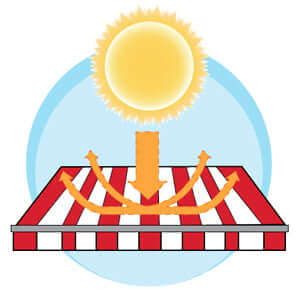
Having assessed the most frequently used fabric, which is acrylic, it appeared that the color choice can make significant improvements in the above-mentioned conditions; This fabric’s technical features along with the selected color allow to solve problems in an amazing way:

(white – beige – yellow), striped light colors:
- UV retention = 80/90%; Solar factor: blocks 70/80% of solar heat;
- light colors limited temperature of bright fabrics compensates for the limited solar factor;
- it is recommended to use this fabric for shading partially open and poorly ventilated areas;
- not recommended for covering glazed surfaces or with the purpose to decrease indoor temperature;
- Transparency: above 20%;
- Atmospheric shade under the awning: warm.

neutral colors (light gray), striped neutral colors:
- UV retention = 94%;
- Solar factor: blocks 80/90% of solar heat;
- Transparency: above 10–20%;
- Atmospheric shade under the awning: temperate.

dark colors (dark green – blue), striped dark colors:
- UV retention = 99%;
- Solar factor: blocks more than 90% of solar heat;
- heat build-up possible at the ends of the fabric: dark colors are recommended for areas that are located high and are well ventilated, where the shaded area is “inhabited”;
- dark colors are perfect for covering glazed surfaces and decreasing indoor temperature;
- Transparency: less than 10%;
- Atmospheric shade under the awning: cool (blue).
Although these characteristics are quite general, we can conclude that dark colors solve the abovementioned problems better; but that does not mean you have to avoid neutral and light colors, the main idea is to create a choices so that consumers can design their own environment where they feel comfortable, choosing not only the type of fabric, but also the color.
Wind and snow load
Our products developed to provide permanent protection from such natural phenomena as wind, rain, and snow, are designed to ensure the best safety standard, even when situated in harsh environment.
Safety assessments related to the products are elaborated in accordance with specifications provided by the national law, issued by the ministerial decree on 16 January 1996, in particular:
Snow load estimation
Load of snow on a surface is estimated based on the “coating form index” and on the “snow load on the ground”:
- coating form index: certain shapes of products can more or less contribute to accumulation or drain of the laid-down snow;
- snow load on the ground: snow load on the ground is an indicator calculated based on historical data on rainfall in different regions of Italy and changes in height, where the tested product is located;
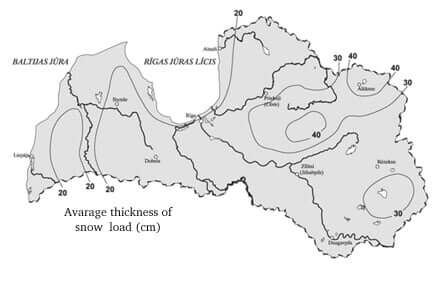
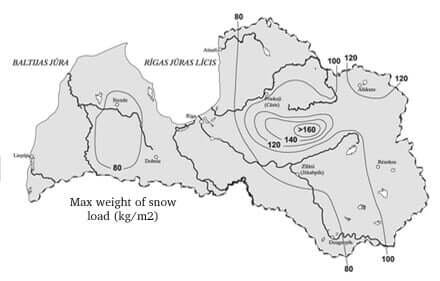
How much does the snow weight?
One cubic meter of fresh (loose) snow weighs from 30 to 60 kg;
As the snow lies down and changes due to the impact of temperature, humidity, wind and other factors, its mass increases up to 200-600 kg (puddled snow), and wet, old snow may even exceed 800 kg!!!
This data allows us to make a conclusion that the end load is quite significant, therefore, it is recommended to clean the snow from the awnings as quickly as possible, as the acrylic fabric or PVC surfaces and their load-bearing structures are not designed to endure such load for a long period of time.
Wind activity evaluation
Wind action is interpreted as high and low pressure acting on both external and internal surfaces of the parts which form the tested structure.
Wind pressure is expressed as follows:
Wind pressure = Kinetic pressure reference x Position factor x Shape factor x Dynamics factor.
- Kinetic pressure reference is calculated based on the “velocity reference” value, that is, based on the data of maximum wind velocity observed in the last 50 years, 10 m above the ground on the area of the 2nd category (uneven, hilly landscape).
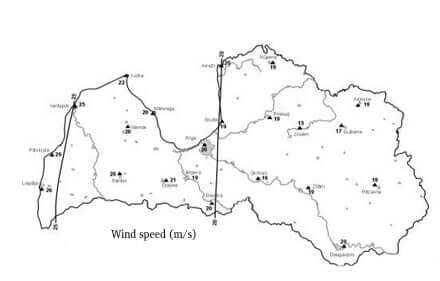
- Position factor: depends on the place where the product is going to be installed, height and location, as well as ground topography and landscape; there are four ground roughness categories for this factor:
A category: urban areas with at least 15% of the surface occupied by buildings with an average height over 15 m;
B category: urban areas (not of A category), suburban, forest industry;
C category: areas with frequent obstructions (trees, houses, walls, fences, etc.), uneven areas, not typical of A, B, D categories;
D category: territories without any obstructions or with a few isolated obstructions (open fields, airports, agricultural areas, pastures, marshy or sandy areas, snowy or icy surfaces of the seas, lakes, etc.).
- Shape factor or aerodynamic factor is associated with a product’s shape ability to be circulated by wind.
- Dynamics factor is taken into account considering reduction effects associated with pressure, but not simultaneity, and with expansion effects related to the structural vibrations.
Wind pressure categories
To better understand wind pressure, that is mentioned in standard UNI EN 13561/2004, we enclose this table.
Beaufort scale
| Wind speed in knots | Wind speed, m/s | Description | Character |
| 0 | 0-0,20 | Calm | Calm. Smoke rises vertically. |
| 1 | 0,30-1,50 | Light air | Smoke drift indicates wind direction. Leaves and wind vanes are stationary. |
| 2 | 1,60-3,30 | Light breeze | Wind felt on exposed skin. Leaves rustle. Wind vanes begin to move. |
| 3 | 3,40-5,40 | Gentle breeze | Leaves and small twigs constantly moving, light flags extended. Large wavelets. Crests begin to break; scattered whitecaps |
| 4 | 5,50-7,90 | Moderate breeze | Dust and loose paper raised. Small branches begin to move.Small waves with breaking crests. Fairly frequent whitecaps. |
| 5 | 8,00-10,70 | Fresh breeze | Branches of a moderate size move. Small trees in leaf begin to sway. Moderate waves of some length. Many whitecaps. Small amounts of spray. |
| 6 | 10,80-13,80 | Strong breeze | Large branches in motion. Whistling heard in overhead wires. Umbrella use becomes difficult. Empty plastic bins tip over. Long waves begin to form. White foam crests are very frequent. Some airborne spray is present. |
| 7 | 13,90-17,10 | High wind, moderate gale, near gale | Sea heaps up. Some foam from breaking waves is blown into streaks along wind direction. Moderate amounts of airborne spray. Whole trees in motion. Effort needed to walk against the wind. |
| 8 | 17,20-20,70 | Gale, fresh gale | Moderately high waves with breaking crests forming spindrift. Well-marked streaks of foam are blown along wind direction. Considerable airborne spray. Some twigs broken from trees. Cars veer on road. Progress on foot is seriously impeded. |
| 9 | 20,80-24,40 | Strong gale | High waves whose crests sometimes roll over. Dense foam is blown along wind direction. Large amounts of airborne spray may begin to reduce visibility. Some branches break off trees, and some small trees blow over. Construction/temporary signs and barricades blow over. |
| 10 | 24,50-28,40 | Storm, whole gale | Trees are broken off or uprooted, structural damage likely. Considerable tumbling of waves with heavy impact. Large amounts of airborne spray reduce visibility. |
| 11 | 28,50-32,60 | Violent storm | Widespread vegetation and structural damage likely. Very large amounts of airborne spray severely reduce visibility. |
| 12 | 32,70-vairāk | Hurricane force | Huge waves. Sea is completely white with foam and spray. Air is filled with driving spray, greatly reducing visibility. Severe widespread damage to vegetation and structures. Debris and unsecured objects are hurled about. |

